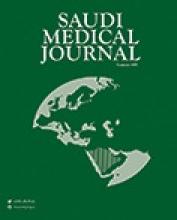Abstract
OBJECTIVE: To compare myocardial injury caused by 3 commonly used methods for coronary artery bypass grafting (CABG).
METHODS: A prospective randomized study conducted at King Khalid University Hospital, Riyadh, Kingdom of Saudi Arabia. The study started in February 2003 and concluded in April 2004 after including 45 patients (15 patients in each of 3 sub-groups) who fulfilled the inclusion and exclusion criteria. The subgroups included coronary artery bypass surgery performed by: a) conventional technique, b) off-pump technique, and c) on-pump beating-heart techniques. All patients had similar operative risk profiles. Their ages were 70 years or less with an ejection fraction of 30-50%. The creatine kinase, myocardial band (CKMB) levels were determined 2 hours after arrival from the operating room then, at 4 hours, 6 hours, and 12 hours. The comparison of creatine phosphokinase and CKMB levels was carried out using analysis of variance with repeated measures. The p-values were used to evaluate the significance of differences.
RESULTS: The pre-operative characteristics including age, gender, ethnic origin, diabetes mellitus, hypertension, and left ventricular function, were similar in the 3 groups. All groups had a median number of 3 bypass grafts. The stay in the intensive care unit and the duration of inotropes were shortest in the off-pump group, but the difference was not significant. There was a peak of CKMB levels at 6 hours in all groups. The trend of CKMB level showed significantly higher values in the conventional CABG group as compared with the other 2 groups.
CONCLUSION: This study indicates that the off-pump technique provides better myocardial preservation than other methods.
- Copyright: © Saudi Medical Journal
This is an open-access article distributed under the terms of the Creative Commons Attribution-Noncommercial-Share Alike 3.0 Unported, which permits unrestricted use, distribution, and reproduction in any medium, provided the original work is properly cited.






